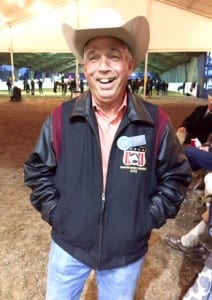As the largest horse show of the year, the Congress is always a hot spot for hot topics. One of the hot button issues at this year’s show is that some believe that the Limited division should have stricter eligibility rules which would make it more difficult for the upper echelon of competitors to become eligible.
Congress Limited rules state that the top riders – ranging from 10 in non-pro hunter under saddle, to 35 in open western pleasure, are ineligible to compete in the Limited division based on their five-year earnings. The number of top riders ineligible for Limited is calculated by average entries. Riders may move in and out of Limited within that five-year period as their earnings increase or decrease.
Congress calculates their earnings on money earned only at the Congress. For instance, a rider may be within the top ten non-pro hunter under saddle riders, but they take two years off from showing at the Congress. Their lack of money earned will take them out of that top-ten group of riders. Then, they are eligible to show at Congress in the Limited.
 NSBA operates with similar rules. However, they use a three-year rotation of earnings rather than five. For instance, the NSBA rulebook states, “All Non-Pro Hunter Under Saddle riders are eligible for participation in any Limited class, except those in the quarter million dollar club, or in the Top 10 money earners in Non-Pro Hunter Under Saddle in the last three years.”
NSBA operates with similar rules. However, they use a three-year rotation of earnings rather than five. For instance, the NSBA rulebook states, “All Non-Pro Hunter Under Saddle riders are eligible for participation in any Limited class, except those in the quarter million dollar club, or in the Top 10 money earners in Non-Pro Hunter Under Saddle in the last three years.”
GoHorseShow spoke with the Ohio Quarter Horse Association and the NSBA about how their limited eligibility rules are determined and what they believe is best for the industry. Executive Director of NSBA, Dianne Eppers, believes it’s important for any association to listen to its exhibitors and adjust their policies accordingly. She says, “We used to have an earnings cap for the limited division, but we found that it wasn’t giving people an opportunity to roll back into the Limited. So, we looked to see if changing that would increase participation, and it has.”
 NSBA Past President and APHA Director of Judges, David Dellin adds, “The object for any association is to create guidelines that service the majority, not just the few. As an association, we are constantly evaluating our results to see if we’re on the right path. We want to make it as a level playing field as possible.”
NSBA Past President and APHA Director of Judges, David Dellin adds, “The object for any association is to create guidelines that service the majority, not just the few. As an association, we are constantly evaluating our results to see if we’re on the right path. We want to make it as a level playing field as possible.”
OQHA President, Hank Clason (right), also believes in creating a level playing field. He believes that the Congress Limited eligibility rules, as they now stand, create a fair system for the majority of competitors. “The Limited division was designed to make showing inviting for those just starting out. If people know they can compete on an equal playing field, they will be more likely to come out and show.” He adds, “But there are flaws in every system. Given how the rules work, it is possible that a few s uperstars could rotate back into the Limited division. Yet, we need to be fair to everyone, and it becomes a problem when you start picking on the rider.”
uperstars could rotate back into the Limited division. Yet, we need to be fair to everyone, and it becomes a problem when you start picking on the rider.”
In Clason’s view, the Limited division is intended to encourage participation. He says it’s unfair to exclude an individual from the Limited just because they’ve had some success. “A person could come and show one really nice horse. But maybe they sell that horse and buy a two-year-old. Or, maybe someone takes time off to start a family, or go to school. A lot can change in the amount of time they’ve set out. Should we kick them out because of one great horse?”
Clason says this is why the Congress operates on a five-year, earnings based, system. He goes on to say that no set of rules will ever be perfect, but that OQHA believes in catering to the majority of participants. “We want to be fair to everyone, and we have to consider how everyone—not just a few riders—will be effected.”
GoHorseShow asked many top trainers and amateurs how they feel about the Limited division eligibility rules. Many agreed with the current system, but many gave suggestions about how things might be improved.
 Adam Wainscott – I believe the rules as they apply now are good, but they need to be tweaked. In my opinion, there needs to be a clause that allows for the top horse and rider combinations—say those that have won a World, or Congress championship in the same event—to become permanently ineligible for the limited division. I do think it’s okay for the Congress to have it’s own set of rules, but again, if you win the Congress in a particular class, you should no longer be limited in that class.
Adam Wainscott – I believe the rules as they apply now are good, but they need to be tweaked. In my opinion, there needs to be a clause that allows for the top horse and rider combinations—say those that have won a World, or Congress championship in the same event—to become permanently ineligible for the limited division. I do think it’s okay for the Congress to have it’s own set of rules, but again, if you win the Congress in a particular class, you should no longer be limited in that class.
 Kaleena Weakly – I like the limited division rules at Congress. I can get back into the limited every so often based on how I’ve been doing. It’s all fair if you ask me. Some people haven’t shown in a few years, and it allows them a chance to get back into it. Limited is different than novice, it is based on money not points.
Kaleena Weakly – I like the limited division rules at Congress. I can get back into the limited every so often based on how I’ve been doing. It’s all fair if you ask me. Some people haven’t shown in a few years, and it allows them a chance to get back into it. Limited is different than novice, it is based on money not points.
 Kim Reynolds – The rules should be based on common sense. If you’ve won the open World show or the Congress you shouldn’t be a limited rider. The limited is so big, and it will always be big. When I was younger, I didn’t want to compete against the big time open riders. With the rules the way they are now, there will always be a huge rotation of limited riders, and I don’t feel it’s good for the industry as a whole.
Kim Reynolds – The rules should be based on common sense. If you’ve won the open World show or the Congress you shouldn’t be a limited rider. The limited is so big, and it will always be big. When I was younger, I didn’t want to compete against the big time open riders. With the rules the way they are now, there will always be a huge rotation of limited riders, and I don’t feel it’s good for the industry as a whole.
 Jamie Hylton – I think that things should be less complicated. I think that if the Congress is going to follow some NSBA rules, then they should follow them all. That would make things a lot more exhibitor friendly, and would likely draw more people in to show.
Jamie Hylton – I think that things should be less complicated. I think that if the Congress is going to follow some NSBA rules, then they should follow them all. That would make things a lot more exhibitor friendly, and would likely draw more people in to show.
 Meg DePalma-Whelan – I feel there needs to be consistency across associations. For instance, we shouldn’t have a five-time World champion paint come to the Congress and be limited. That being said, I do like the way the Congress non-pro rules work – a lot can change in five years. Let’s say I take a break for a few years. When I decide to start showing again, I’ll be competing against people who have been showing really hard in my absence. The horse show world evolves, and I believe allowing people to move back into the limited allows them to compensate for those changes.
Meg DePalma-Whelan – I feel there needs to be consistency across associations. For instance, we shouldn’t have a five-time World champion paint come to the Congress and be limited. That being said, I do like the way the Congress non-pro rules work – a lot can change in five years. Let’s say I take a break for a few years. When I decide to start showing again, I’ll be competing against people who have been showing really hard in my absence. The horse show world evolves, and I believe allowing people to move back into the limited allows them to compensate for those changes.
 Robin Frid – I think there should be a higher dollar amount to move out of limited. I also think there needs to be a limit on how many times you can move back and forth between open and limited. Maybe it should only be two or three times that you move back and forth, and then you’re permanently an open rider. Because, once you’ve had that much success you’re probably not a limited rider anymore. I also believe riders need to police themselves and really consider what the limited division is for. It’s designed to give riders a chance to compete against the same caliber horses and riders. If you have a horse you’ve had a lot of success with, then maybe the limited isn’t the place to be showing that horse.
Robin Frid – I think there should be a higher dollar amount to move out of limited. I also think there needs to be a limit on how many times you can move back and forth between open and limited. Maybe it should only be two or three times that you move back and forth, and then you’re permanently an open rider. Because, once you’ve had that much success you’re probably not a limited rider anymore. I also believe riders need to police themselves and really consider what the limited division is for. It’s designed to give riders a chance to compete against the same caliber horses and riders. If you have a horse you’ve had a lot of success with, then maybe the limited isn’t the place to be showing that horse.
 Brent Maxwell – I feel we could have more consistency in our rules. As an association, it’s always good to look at the whole picture, and sometimes you find there are aspects that need to be reevaluated. For instance, I think we need to look at whether futurity earnings outside of the Congress should count towards limited standings. There are people competing in large halter futurities and earning $30,000, then coming to the Congress and competing in the limited division. Maybe we need to find more common ground in order to achieve consistency.
Brent Maxwell – I feel we could have more consistency in our rules. As an association, it’s always good to look at the whole picture, and sometimes you find there are aspects that need to be reevaluated. For instance, I think we need to look at whether futurity earnings outside of the Congress should count towards limited standings. There are people competing in large halter futurities and earning $30,000, then coming to the Congress and competing in the limited division. Maybe we need to find more common ground in order to achieve consistency.
 Terry Cross – When people are showing in the limited division, they want to feel like they have a chance to be successful. Because of that, the rules may need tweaked. Maybe if someone has recently won the Congress, they need to be ineligible for limited for a longer period of time. It might not be that the rules need to be changed, but added to.
Terry Cross – When people are showing in the limited division, they want to feel like they have a chance to be successful. Because of that, the rules may need tweaked. Maybe if someone has recently won the Congress, they need to be ineligible for limited for a longer period of time. It might not be that the rules need to be changed, but added to.
 Gretchen Mathes – I’m okay with the way things are run now. But, I think it gets confusing for the exhibitor when rules are constantly changing. They need to pick one rule and stick with it.
Gretchen Mathes – I’m okay with the way things are run now. But, I think it gets confusing for the exhibitor when rules are constantly changing. They need to pick one rule and stick with it.
 Brad Ost – I think the rules as they are now are really good. I know that sometimes there are horses and riders that people think should not be limited. But, if the rules were changed to a dollar amount cap system, as many people are talking about, there would be bigger disadvantages. A person may show one nice horse, one time, and become ineligible. I love that people are able to come back and show the limited; it gives people more motivation to show.
Brad Ost – I think the rules as they are now are really good. I know that sometimes there are horses and riders that people think should not be limited. But, if the rules were changed to a dollar amount cap system, as many people are talking about, there would be bigger disadvantages. A person may show one nice horse, one time, and become ineligible. I love that people are able to come back and show the limited; it gives people more motivation to show.
 Leslie Lange – I agree with the limited rules here at Congress. As a trainer we often go back and forth between great horses and sub-standard horses. If you go for a period of time without a great one, as people tend to do, it gives you the opportunity to go back in the limited and show against similar caliber horses. There tends to be consistency with the top riders, in that those really great futurity riders will stay out because they always have great ones. But, with some riders floating in and out, it really raises the limited bar, which is what I believe we want as competitors.
Leslie Lange – I agree with the limited rules here at Congress. As a trainer we often go back and forth between great horses and sub-standard horses. If you go for a period of time without a great one, as people tend to do, it gives you the opportunity to go back in the limited and show against similar caliber horses. There tends to be consistency with the top riders, in that those really great futurity riders will stay out because they always have great ones. But, with some riders floating in and out, it really raises the limited bar, which is what I believe we want as competitors.
 Alexandra Chavez – Everyone should have a chance to win. I think the way to do that would be to make the limited eligibility based on the horse and not the rider. Just because you can buy the nicest horse doesn’t mean you should be able to go out and win the limited. People want to compete on an equal playing field. So, if someone goes out and buys a World or Congress champion, they shouldn’t be eligible to compete in the limited division. If shows want more participation they should consider changing the rules to reflect a horse’s accomplishments.
Alexandra Chavez – Everyone should have a chance to win. I think the way to do that would be to make the limited eligibility based on the horse and not the rider. Just because you can buy the nicest horse doesn’t mean you should be able to go out and win the limited. People want to compete on an equal playing field. So, if someone goes out and buys a World or Congress champion, they shouldn’t be eligible to compete in the limited division. If shows want more participation they should consider changing the rules to reflect a horse’s accomplishments.
What do you think? Should the Limited eligibility rules at Congress be changed? If so, how could they be improved? Let us know in the comments section of this article.









